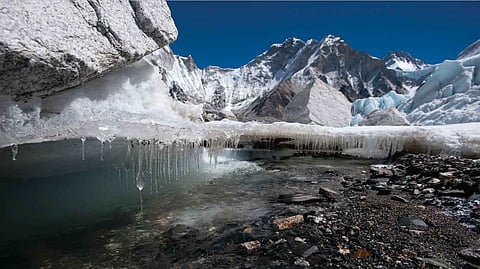
Efforts to combat the effects of global warming are contained in a series of commitments adopted in the 2015 Paris Agreements by nearly 200 countries.
The most ambitious is to keep the global average temperature rise below 2°C above pre-industrial levels, and preferably limit it to 1.5°C, to avoid further depletion of ice at the poles, sea level rise, and increase in extreme weather events.
But even if this goal is met, various parts of the world will still be in danger. One of them is the region that includes the Hindu Kush and the Himalayas (HKH), home to more than 50,000 glaciers and the highest peaks in the world, such as Everest and K2. Known as the third pole, its vast reservoir of ice is the largest on Earth after the Arctic and Antarctica.
An extensive investigation carried out by more than 200 experts has been made public, revealing that the foreseeable increase of two degrees in the global average temperature will mean an increase of 2.7°C in this region and that half of its glaciers will melt. But, even if the goal of not exceeding one and a half degrees is achieved, by the end of the century the increase will be 2.1°C in the mountain range and a third of its ice mass will disappear.
As a consequence of this phenomenon, the main rivers of Asia will be destabilized and this will affect that quarter of humanity that depends on them: directly, the 250 million people who live in these mountains and by extension another 1,650 million who live in the valleys of its rivers.
"This is a climate crisis that has not been heard of," warns Philippus Wester, scientist and coordinator of the Hindu Kush Himalaya Monitoring and Assessment Program (HIMAP), in a telephone conversation. The result of this initiative is a 627-page document produced over the past five years at the International Center for Integral Mountain Development (Icimod), a learning institution serving the eight countries located within the 3,500-kilometer mountain range. . region (Afghanistan, Bangladesh, Bhutan, China, India, Myanmar, Nepal and Pakistan) to help understand and adapt to climate change.
The findings are "alarming," in Wester's words. In November 2018, the UN Intergovernmental Panel on Climate Change (IPCC) already called for drastic measures after warning that the average global temperature has risen by one degree compared to pre-industrial levels due to greenhouse gas emissions. greenhouse effect as man-made carbon dioxide (CO 2 ), and between 2030 and 2052 this increase is likely to be 1.5 °C if the current rate of emissions is maintained, which should be reduced to at least half in the next decade.
The Hindu Kush and Himalayan region was formed 70 million years ago, and it was not until the 1970s that its ice masses began to decline. "14% of the third pole has already been lost," says Wester. In the worst-case scenario, if global warming is not contained, the study warns that current emissions would cause a rise of up to five degrees in the mountains and the loss of two-thirds of their glaciers by 2100.
The worsening of the current conditions would mean more disasters and sudden changes that can lead to the outbreak of conflicts between the affected countries. "HKH is geologically fragile, with young mountains that are vulnerable to erosion and landslides even without human interference. The region is undergoing rapid transformation driven by forces such as climate change, natural disasters, economic growth, globalization, infrastructure development, migration and land use change. These changes are having and will have important consequences, not only for the people living in the region but also globally," the report says.
Wester explains why the temperature in the mountains rises more than the global: "This figure of 1.5 is an average. Temperatures in the oceans vary more slowly than on land," he reasons. And he provides a second reason: "We're finding in mountains what we call elevation-predicted warming." This phenomenon, of which there are numerous studies, means that the higher the altitude, the higher the temperature, which is why high mountain environments experience faster changes than those located at lower altitudes.
"We don't really know why it happens, it's a very interesting thing that we've seen over the last 100 years."
Current emissions would lead to a rise of up to five degrees in the mountains and a loss of two-thirds of their glaciers by 2100.
The study has exhaustively broken down different aspects of the region: from tourism to job creation, from women's rights to biodiversity, agriculture, or the use of energy. And throughout its pages, it makes innumerable recommendations addressed to the international political sphere, companies, institutions, civil society, and other actors involved in the future of the climate on our planet.
(The Author is a Journalist based in Jammu and Kashmir. He writes on environment-related issues, Climate Change in South Asia.)
You can also join our WhatsApp group to get premium and selected news of The Mooknayak on WhatsApp. Click here to join the WhatsApp group.